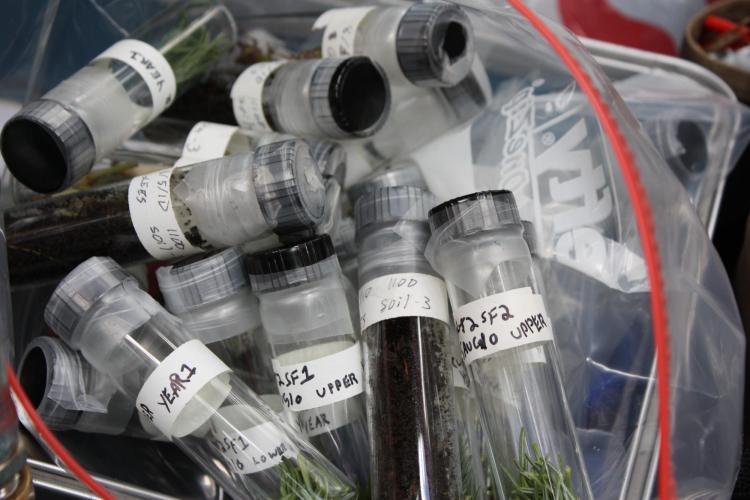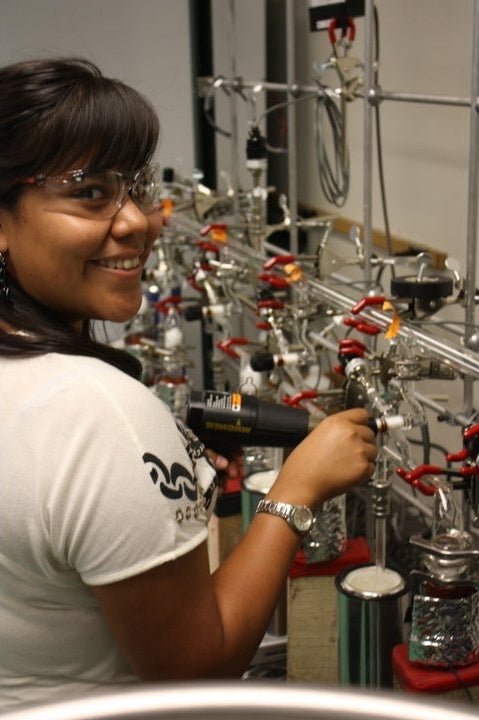Ecohydrology Lab
We are focused on investigating how vegetation processes affect water flow dynamics and pathways in soil and streams, and conversely, how water flow paths affect vegetation function in mountainous terrain. The ultimate goal is to improve our knowledge of how changes in land-use and/or climate will affect water resources and ecosystems. Our interdisciplinary research uses state-of-the-art techniques to reveal patterns and processes at scales ranging from the leaf to the watershed.
- Jennifer Pensky, Postdoctoral Scholar
- Kyotaek Hwang, Postdoctoral Scholar
- Sáde Cromratie Clemons, Grad student
- Mykael Pineda, undergraduate honors student; now graduate student at UC Merced
- Reece Gregory, undergraduate honors student; now research technician at Oregon State University
- Hallie Adams, MA Student; making the world a better place.
- Ethan Burns, MA Student; now teaching at the Watershed School, Boulder
- Dr. Sidney Bush, PhD Student; now postdoctoral scholar, Oregon State University
- Dr. Andrew Birch, PhD Student; now Water Quality Program Lead at National Park Service
- Isaac Bukoski, MA Student; now Geologist at Knight Piesold Consulting
- Dr. David Barnard, CZO Postdoc; now Research Agroecologist at USDA
- Daphne Szutu, Lab Manager; now at UC Berkeley Biomet Lab
- Dr. Erin Berryman, Postdoc; now Quantitative Ecologist with USDA Forest Service
- Jackie Romero, RESESS Intern; now admissions counselor at Southern Methodist University
- Breanna Skeets, RESESS Intern and Research Assistant; now Manager at Bank of America
- Margaret Burns, MA student; now Project Manager/Hydrologist at FB Environmental Associates
- Anna Vinton, Undergraduate Researcher; now NSF Post-doc at Oxford University
- Alex Loomis, BA Geography and Environmental Studies 2013, Undergraduate Honors Thesis Student; now Quantitative Conservation Ecologist with USGS
- Mark Barckholtz, Undergraduate Researcher; now Building Analyst with CLEAResult
- Traeger Meyer, Undergraduate Researcher; now support engineer at Google
- Ken Eggering, Undergraduate Researcher; now GIS Specialist with Jacobs Engineering
- Michelle Harrison, Undergraduate Researcher; Hydrologic Engineering Intern at Alaska Department of Transportation
Contact
Holly Barnard Phone: 303 735-7062
Blog headlines
- Holly Barnard receives awards from Boulder Faculty Assembly and the A&S Diversity Committee
- New publications
- Congratulations Dr. Andrew Birch!
- New publication
Research
The links between streamflow and forests are poorly understood. Processes operating in the hydrosphere, biosphere, and geosphere interact at multiple scales to determine the structure, function and health of terrestrial ecosystems. Although numerous studies have examined soil hydrologic processes, vegetation function, and micro-climate independently, investigating the feedbacks among these core areas has only recently become a research priority. Fundamental questions of forests' effect on the hydrologic cycle remain unanswered: At what depth do trees access soil moisture? To what extent does transpiration affect streamflow? Why do some vegetation processes seem tightly coupled to climate, whereas, streamflow dynamics are dominated by threshold behavior? Detailed process-based studies that explore the interface between plant physiological function and watershed flowpaths and dynamics have not widely been attempted. However, these studies are fundamental to how the subsurface reservoir is viewed by hydrologists and ecologists alike. The CU Ecohydrology lab investigates the links between forests, soil water, and streamflow in a water resources context. We use field sampling, stable isotope techniques, and spatial modeling to advance our ecohydrological understanding.
2020-2025: Collaborative Research: Network Cluster: Quantifying controls and feedbacks of dynamic storage on critical zone processes in western montane watersheds, National Science Foundation, Critical Zone Collaborative Network Program, $6.9M, Barnard - PI. A collaboration of nine PIs from six institutions.
2015-2018: Collaborative Research: From Roots to Rock - Linking Evapotranspiration and Groundwater Fluxes in the Critical Zone, National Science Foundation, Hydrologic Sciences Program, $454,097, Barnard - PI. In collaboration with Dr. Kamini Singha at Colorado School of Mines.
2014-2017: Collaborative Research: Planning And Land Management in Tropical Ecosystem; Complexities of land-use and hydrology coupling in the Panama Canal Watershed, National Science Foundation, Water Sustainability and Climate Program, $2.8M, Barnard - PI. In collaboration with University of Wyoming (lead institution) and Smithsonian Tropical Research Institute.
2011-2015: Carbon-Water Cycling in the Critical Zone: Understanding Ecosystem Process Variability Across Complex Terrain, U.S. Department of Energy Terrestrial Ecosystem Science Program, $647,020, Barnard - PI.
Services
The Ecohydrology Lab offers stable isotope analysis of 2H and 18O using the PICARRO L2120-i. The PICARRO L2120-i provides simultaneous, high precision 2H and 18O measurements. Dr. Holly Barnard oversees the instrument and its operations. We use Picarro's ChemCorrect™ software to identify and quantify organic contamination in extracted plant and soil samples. In the future, we plan to add a microcombustion module for samples with high organic content.
Contact Dr. Barnard prior to mailing and submitting samples. All samples are required to be filtered prior to analysis to maintain instrument performance. If filtering is a problem due to small sample size, we can discuss. The Ecohydrology lab is not responsible for samples that are broken in the mail during shipping to the lab. CU-Boulder students with a small number of pilot project samples should contact Dr. Barnard about student discounts.
Price
$10.50/sample at the off-campus rate (USD)
2H and 18O (‰) measured on the Picarro L2120-i

J. Romero and R. Feist (Colorado School of Mines graduate student) record data from their "geophysics tree."
How to join
The Barnard Ecohydrology lab is always looking for well-qualified, enthusiastic students to join our group.
Undergraduates interested in research experience or potential senior projects should contact Dr. Barnard.
Prospective graduate students should examine the current publications and lab webpage to determine if the Ecohydrology Lab has interests compatible with their own. Potential graduate students are encouraged to contact Dr. Barnard in advance of applying to the department to discuss research projects and funding opportunities.
Here are some helpful resources for students interested in pursuing graduate school (special hat tip to ATOC graduate students):
- Applying to graduate school: tips, timeline, and tools of the trade (PDF).
- Why and how to email faculty prior to applying to graduate school.
- So, you want to go to grad school? Nail the inquiry email.
- How to write a flawless CV (Curriculum Vitae) for graduate school.
- How to write a CV for graduate school: 7 expert tips.
- Writing a graduate school personal statement.
- Writing the statement of purpose
Participation of underrepresented and underserved groups
Image: B. Skeets (RESESS Intern & Research Assistant) extracts water from soil and xylem samples using cryogenic vacuum distillation line.
Our lab supports broadening participation of underrepresented and underserved groups in science. Dr. Barnard serves as a science mentor for the NSF-funded UNAVCO Research Experience in Solid Earth Science for Students (RESESS) and as a program and meeting mentor for the Minorities Striving and Pursuing Higher Degrees (MSPHDs) program.
Anti-racism and anti-discrimination resources
The INSTAAR Ecohydrology Lab is committed to creating a program that feels inclusive and supportive for people from all backgrounds and identities. Our lab want to help every member of INSTAAR find a support network that feels right for them/her/him. Our lab works in collaboration with the institute's AllSTAARs Task Force to advance departmental diversity and inclusion efforts. It is our responsibility to educate ourselves about diversity issues in STEM, and to learn how best to combat bias and prejudice and to promote social equality.
A growing list of resources concerning diversity issues in STEM can be found below (special thanks to the Taylor Lab in EBIO for compiling many of these resources):
Publications
- "Diversity in STEM - What it is and why it matters?" Scientific American Blog
- To learn inclusion skills, make it personal - Nature
- "Diversity: Pride in science" - Nature - on being LGBTQ in STEM
- What does it take to make an institution more diverse? - Nature
- Help that hurts women - Inside Higher ED (regarding letters of reccomendation)
- "Women in Science" Nature - Special Issue
- Understanding unconscious bias - Royal Society video
- How Diversity Makes Us Smarter - Scientific American
- Opinion: Gender Diversity Leads to Better Science - PNAS
Training
Our outreach
Education extends beyond the classroom and laboratory. The Ecohydrology group is committed to promoting science and engaging with students to expand their growth and opportunities. We engage with K-12 students, undergraduates and greater community.
Earth Explorers
In 2014-15, Holly Barnard has been a volunteer scientist with the Earth Explorers program which is located in Longmont, CO. Earth Explorers is an independent nonprofit that provides Science and Filmmaking Education programs to middle-schoolers who need it the most. Students learn not only about science, but also how to make a film. Working with this group of students is extremely rewarding and super fun.
Fall 2014 Earth Explorers Production: Holly Barnard and the Crazy Tree Lady Caper
Research Experience in Solid Earth Science for Students (RESESS)
As part of our research projects, the Ecohydrology lab recruits underrepresented students at the undergraduate level to the earth sciences via the NSF-funded UNAVCO RESESS program. RESESS is an undergraduate summer internship program that is dedicated to increasing diversity in the geosciences located in Boulder, CO. Barnard has served a RESESS mentor for three years.
Research Experience for Community College Students (RECCS)
The RECCS summer research internship program in critical zone science is available to community college students from across Colorado. This research opportunity offers a unique opportunity to conduct research, both field and lab based, while working with a team of scientists. Students will learn basic research, writing and communication skills, and they will present their research at a local student science symposium, as well at a national conference.
In the field

T. Meyer installs sapflow sensors at the Niwot Ridge LTER.

Soil and foliage samples collected for isotopic analysis.
News
An error has occured - please check your filters and try again
An error has occured with the API - please try again later
Publications
Publications for Barnard are included below









